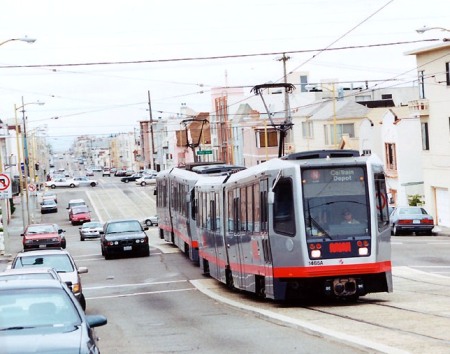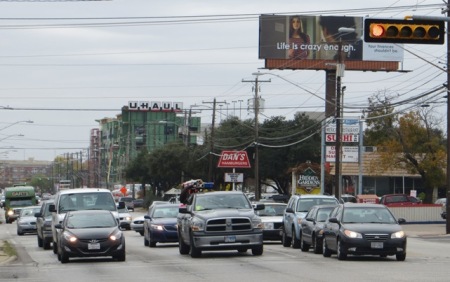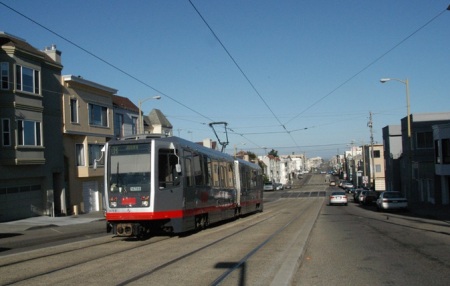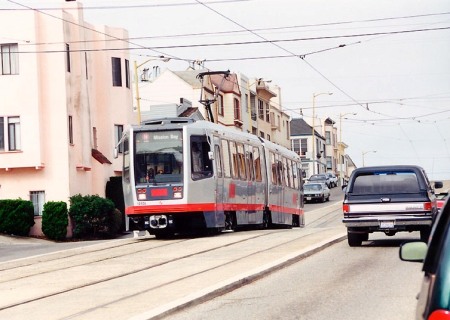
San Francisco’s N-Judah Muni Metro line shows design option for light rail in Austin’s Guadalupe-Lamar corridor
9 December 2014
N-Judah Line Muni Metro light rail transit (LRT) train running in raised median on San Francisco’s Judah St. Alignment in this constricted 80-foot-wide arterial includes space for 2 dedicated light rail tracks, 4 vehicle lanes, and shared sidewalk for pedestrians and bicyclists. Similar alignment design could fit dedicated LRT tracks, 4 traffic lanes, and sidewalks into Austin’s Guadalupe-Lamar corridor. Photo (copyright) Eric Haas.
♦
In recent years, critics of installing “urban rail” — i.e., a light rail transit (LRT) line — in the Guadalupe-Lamar (G-L) corridor have endeavored to portray this potential project as an impossibly daunting task, contrary to many years of local planning to do just that. The predominant contention is that these two busy major arterials are simply too narrow to accommodate a double-track LRT alignment on dedicated lanes while maintaining adequate general traffic flow, and that introducing LRT would require either heavy civil works construction, or extensive, costly acquisition of adjacent property to widen the right-of-way (ROW), or both.
However, the G-L travel corridor — most central in the city — actually carries the heaviest travel flow of local arterials, serves the highest-density neighborhoods; and connects the most important activity clusters; thus, ultimately, given the inherent constraints of motor vehicle transportation, some type of high-quality, high-capacity public transport alternative is essential to maintain long-term mobility. Fortunately, there are LRT alignment designs that would facilitate fitting affordable, cost-effective, surface LRT into these arterials, while maintaining at least four lanes of general traffic capacity through most of the corridor.
While this corridor is characterized by an unusually narrow roadway structure — much of both North Lamar Blvd. and Guadalupe St. have total ROW (including sidewalks and curbs) just 80 feet wide — there appears to be adequate ROW width to install dedicated LRT lanes, within a 24-foot reservation, without additional ROW acquisition (easements), together with four traffic lanes (two 10-ft lanes per direction) for most of the alignment, plus sidewalks and curbs (8 fteet) on each side.

North Lamar Blvd. has unusually narrow right-of-way width for heavily traveled central local arterial street. Conditions of Guadalupe St. are similar. Photo: L. Henry.
For stations, relatively short segments of additional ROW would need to be acquired — approximately 20 feet of width for 300 feet (about one block) on each side of major intersections intended as station sites. Acquiring wider ROW would also be useful along sections of Guadalupe St. (particularly where the proposed LRT alignment runs adjacent to stretches of state-owned land). Within the Drag section of Guadalupe (W. 29th St. to MLK Blvd.), dedicated LRT lanes could remain in the center of the arterial, with some reconfiguration of traffic lanes and other facilities.
ROW constraints will impact the traction electrification system (TES) and overhead contact system (OCS) design in the G-L corridor. (OCS is the commonly used term for the overhead power wire system; it can be catenary or a simple, single-trolley-wire design.)
Appropriate design of the TES is critical to the narrow overall alignment design required in this corridor. Unlike many other modern new-start LRT installations, for OCS power wire suspension this alignment design would eschew TES center poles (masts) with bracket arms. Instead, to facilitate adequately narrow LRT ROW, this design would use an alternative design whereby the OCS would be carried by cross-span cables suspended from side poles inserted at curbside. Examples of this type of OCS suspension can be found in other LRT installations, such as in Houston, San Diego, and San Jose. (Whether OCS is simple trolley wire or catenary-type suspension would not affect this aspect of alignment design.)
The following schematic diagram illustrates a cross-section of this design for the majority of both North Lamar and Guadalupe, with LRT running in a dedicated reservation, two traffic lanes on each side, and sidewalks shared by pedestrians and bicyclists on each side.

Cross-sectional diagram of major arterials in corridor, showing center LRT reservation, traffic lanes, sidwalks, and side-mounted TES poles for suspending the OCS. Graphic: ARN. (Click to enlarge.)
For such a configuration of an LRT reservation within a major arterial, constrained by narrow ROW width, San Francisco offers perhaps the closest operating example with the N-Judah Line of the Muni Metro LRT system that branches westward from the city center. For a roughly 10-block section along Judah St., from about 9th Avenue to 19th Avenue, LRT tracks are laid in a raised dedicated reservation that isolates them from motor vehicle traffic; eliminating the need for additional barriers such as channelization buttons or other separation devices, this design has the benefit of minimizing horizontal clearance.
As the photo at the top of this post illustrates, despite a ROW constraint of just 80 feet, this configuration of the major Judah St. arterial is able to provide the raised LRT reservation plus 4 motor vehicle lanes plus parallel sidewalks. It should not be difficult to envision a similar design working in Austin’s Guadalupe-Lamar corridor.
In the overhead view shown in the photo below, the top of a Muni Metro train can be seen in the center, running on the upper of the two tracks in the reservation. The different allocation of ROW space for traffic and sidewalk can be noticed — San Francisco provides an on-street parking lane and a traffic lane on each side of the arterial, plus sidewalks nearly 11 feet in width. In contrast, Austin Rail Now recommends that Guadalupe-Lamar would have 4 full traffic lanes of 10-ft width, no parking lanes, and 8-ft sidewalks.

Aerial view of Judah St. corridor segment near 10th Ave., showing central reservation with Muni Metro LRT train, motor vehicle lanes on each side, and sidewalks on each side of arterial. Photo: Google Maps Satellite View. (Click to enlarge.)
The following two photos at surface level showing Muni Metro trains in the Judah St. reservation further suggest how efficient LRT service can be installed in the relatively constrained arterial ROW of Austin’s Guadalupe-Lamar corridor.

In this view of single-car train on slightly raised median near 16th Avenue, transverse spanwire that holds OCS power wire can be seen behind train, suspended between TES poles on either side of street. TES poles also serve as street light masts, a typical dual function. PHOTO: Peter Ehrlich.

In this view of a train near 16th Avenue, the slightly raised center median reservation can be seen more clearly. Over the train, transverse spanwires holding OCS can be seen; other cross-wires are general utility cables. Photo (copyright) Eric Haas.
There are other alternatives for installing LRT in the Guadalupe-Lamar corridor. To eliminate the need for TES poles, for example, there are “wireless” power options, but these tend to be proprietary, somewhat experimental technologies and substantially more expensive. Widening these arterials by acquiring more ROW is another option, but this also introduces greater expense. We believe that the raised-median design, with side-mounted TES poles, presented here, represents a particularly cost-effective, functional solution worth considering for G-L and other major Austin corridors. ■

The obsession of this site on having rail on Lamar and Guadalupe only is amusing to say the least. Lamar-Guadalupe or death to rail! (Wither South Austin?)
Our articles have consistently framed a Guadalupe-Lamar light rail transit (LRT) starter line as merely the initial step to achieve our vision of an eventual citywide — and region-wide — LRT system, perhaps dozens of miles in extent, of which Guadalupe-Lamar would be merely the “spine”. We’ve repeatedly contended that a properly planned, properly positioned, cost-effective, affordable starter line is the essential prerequisite to manage resources adequate to achieve such a crucially important extensive system.
For example:
• Project Connect Needs an Overhaul (7 December 2013):
• Dobbs: “Why are we squandering our best asset?” (22 December 2013):
• Project Connect’s urban rail plan “costs way too much to do too little” (3 May 2014)
• Austin Business Journal guru slams Highland-Riverside urban rail proposal as “a very small plan benefiting a limited group of people” (6 June 2014):
• Project Connect’s urban rail plan is “worse than nothing” (21 July 2014):
• A “Plan B” proposal for a Guadalupe-Lamar alternative urban rail starter line (5 October 2014):
Achieving such a broadly expansive system throughout Austin and its surrounding region is crucial to maintaining the mobility and livability of this area. A prudent, cost-effective, and affordable starter line in the Guadalupe-Lamar corridor is the critical first step toward realizing that vision.
— ARN editor
..
Guadalupe & Lamar are the obvious choice for a light rail line, given the density surrounding them and the popularity of the #1 bus, but I’d always had trouble envisioning how light rail could fit on them. This is the first time I’ve seen anyone explain how a G/L line could fit – nice!
What you may find even more amusing is that the author of this article and the publisher of this site are both South Austin residents of over 45 years.
So why the obsession with Guadalupe/North Lamar as a place to start? It’s where the riders are, where the buses carry the most passengers, where the congestion is and where urban rail will be seen as an unqualified success to the community as a whole.
As retired Capital Metro senior planner, Surinder Marwaha, has observed, the Guadalupe/North Lamar corridor is where Austin’s highest density and transit ridership is, where all the affected neighborhoods have city-approved development plans (ordinances) with rail as a major component of their development plans and where denser mixed-use development with a wide range of housing options is primed to occur if the unmet travel demand can be satisfied. For these reasons Marwaha says a GL-NL light rail project would be highly competitive against other cities nationwide for increasingly scarce federal new starts capital funding. He points out that this six-mile corridor connects 7 major activity centers, unmatched by any other corridor in the city.
Given that we must start somewhere and can’t build rail everywhere at once, it only makes sense to do it where it’s needed most and where it will have the highest ROI. Extending urban rail south of the river will be much easier once we have the first piece of urban rail in the right place.
Finally, because Guadalupe/North Lamar is the best place to begin, much of the planning has already been done and needs only to be updated as seen on the FTA’s webpage from 2000.
http://www.fta.dot.gov/12304_3104.html
Dave Dobbs, Publisher, Light Rail Now!
[…] a December posting, ARN presented a proposed design to install dedicated LRT tracks in North Lamar Blvd. and Guadalupe St., while retaining four lanes […]